English Electric Canberra - History
In 1944, with the tide of WW2 well and truly turning, the fastest and most accurate bomber the RAF had was the twin-engined de Havilland Mosquito; unlike the 4 engine 'heavies', the lightweight Mosquito relied upon speed to avoid fighter defences, and it was a natural extension of this concept to consider the possibilities of a jet powered bomber that would fly high above ground defences and be effectively immune to attack.
Westland's 'Teddy' Petter, designer of the Lysander army co-operation aircraft and the Whirlwind and Welkin fighters, had a reputation for being difficult with little time for anybody's feedback on the less successful aspects of his designs, but Westland's performance in building - and improving - Spitfires throughout the war had given the Ministry of Aircraft Production confidence in his abilities and so he was instrumental in the writing up of the B.1/44 specification for a jet powered bomber in cooperation with the Ministry. Without a contract, he had Westlands begin work on a pair of designs (one tricycle landing gear and one tailwheel), with resembled the Mosquito in many ways but buried a pair of jet engines in the fuselage instead of piston engines out on the wing. Convincing Westlands' board to fund the construction of a mockup fuselage, Petter then absented himself from work for some weeks during a period of stress. He returned to find the bomber efforts had been dumped in favour of working on a new fighter requirement (which led to the Wyvern). Incensed, he resigned from Westlands and joined English Electric at Preston. EE had been successfully manufacturing Hampdens and Halifaxes for Handley-Page, but had no design team of their own. Petter therefore had a free reign to put together his own 'dream team' and continue work on the B.1/44.
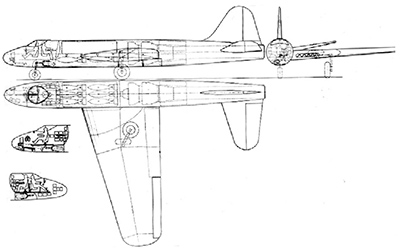
The single engine design of May 1945; BAE Systems
Building a jet bomber from a clean sheet would have been a challenge for any company, but for EE, it was an especially challenging prospect. They really were starting from fresh, and that included infrastructure. Wind tunnels were built, the airfield at Warton cleared up and made into their flight testing base, and Petter put together what would eventually become a 260 strong design team including the aerodynamic genius Ray Creasey and structural and stress wizard Frederick Page. Petter's design had evolved to have a single large jet engine in the fuselage with intakes in the wing roots but by late 1945, but Page felt the lack of space left in the fuselage for fuel and bombs required a change of tack. Specification B.3/45 was issued, firming up the requirement and outlining an aircraft with twin Avon engines, a crew of two with ejector seats and performance that hugely outstripped that of the Mosquito - 440 kts at 40,000 ft, a service ceiling of 50,000 ft, a range of 1400 miles and radar and visual bomb aiming facilities. The mid-1945 design was redrawn with two engines, embedded in the wing roots. Wing Commander Roland Beamont was recruited to be EE's chief test pilot, his wartime experience on the Typhooon and Tempest and experience with the Meteor being judged to be essential for the new jet bomber
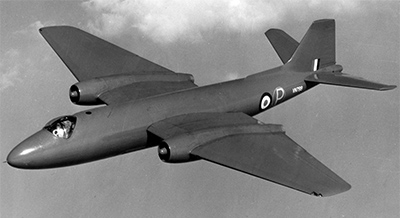
Canberra prototype VN799; BAE Systems
By 1947, work on what was known as the English Electric A.1 was proceeding at pace, with detailed design work well underway and a wooden mockup constructed at Warton. The old Westland design was still visible but now it had engines in nacelles embedded further out on the wing as an insurance policy to cope with a possible switch to another engine (changes in nacelle size were easier than redesigning the entire wing). Going against tradition, much of the aircraft was built on custom jigs and tooling from the outset rather than having an essentially handmade prototype. Petter's choice of team clearly paid dividends as progress was rapid and by early 1949 the first prototype was essentially complete. The Air Staff were so impressed that firm orders were placed for no less than 5 versions, covering a tactical bomber, blind bomber, target marker bomber, long range photo recce and a trainer variant - basically copying the most useful variants of the Mosquito.
In March 1949 the first engines arrived and installing them in the airframe and getting it ready to fly took until May, with an official roll-out ceremony on the 2nd. On 9th May, some short 'hops' were undertaken to ascertain if the aircraft controls were working well enough for a flight. They were, and the first day with good enough weather was scheduled for the first flight - in the event, that was Friday the 13th! Despite the bad omens of such a date, the first flight went smoothly, with Beamont complaining only of jerky rudder response and an uncomfortably sweaty cockpit - a product of the 'goldfish bowl' canopy turning the cockpit into a greenhouse. Petter batted away suggestions of discomfort, but the rudder was progressively modified to reduce the balance horn area at the top, fixing the jerky response, and a small fairing was added behind the canopy to get rid of vibration found on later higher speed flights. By September the new aircraft had ticked off all of its test programme with remarkably few problems, and EE were confident enough to display at the Farnborough airshow!

Canberra B.2 cutaway; BAE Systems
After an embarrassing flame-out whilst taxiing, Beamont took a delayed slot and thoroughly wrung the aircraft out, with a stunning display of speed and manoeuvrability (albeit a few bits did drop off as a test instrumentation pack decided it had had enough of the high life!). It was a stunning debut, and the representatives of various air forces were thoroughly impressed by the new bomber. The airshow committee were less impressed, and asked Beamont to tone his display down a a bit! As service testing proceeded, the name of Canberra was chosen - no doubt as part of the sales effort to try and get the Australians to buy the jet, with George Nelson, MD of EE choosing the name as he believed strongly in the Commonwealth's importance to world peace and Canberra was the furthest flung Commonwealth capital.
Around this time, though, Petter had had enough of the friction between the his aircraft design shop and the production side of English Electric, and asked to be given full autonomy with a separate experimental engineering division free of any influence from the rest of EE. He didn't get his way, and resigned to join Folland Aircraft, taking a few of his staff with him. Freddy Page, however, stayed. In the meantime, the first of the Canberra's numerous world records was attained in January 1950 (an altitude record with the second prototype reaching 50,000 ft). Another impressive airshow performance at Paris in June 1950 kept the aircraft in the headlines, and then the Korean War broke out.
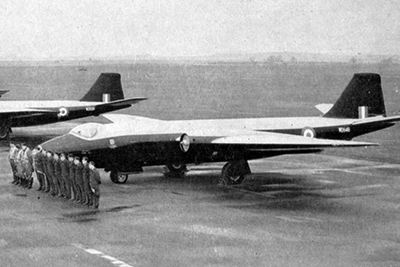
101 Squadron stand up at RAF Binbrook, May 1951; BAE Systems
The UK's armament production had dropped dramatically after WW2, and suddenly we were at war again with a need for production to ramp up once more. The new bomber was one of the programmes chosen to be accelerated, but EE simply didn't have the capacity to oblige - so various other established manufacturers such as Avro were roped in to build the new bomber too. The first version expected to go into service, the B.1, was to have been the 'blind bomber' version - designed to rely upon radar navigation, with the nose taken up by a H2S scanner. Unfortunately the related equipment was experiencing development delays and the Air Ministry soon decided that enough was enough and they'd just go for a visual bomber with a glass nose for traditional bomb aiming. The B.1 was cancelled and work moved on to the B.2, the tactical bomber (though in practice it would also be part of the strategic Main Force of Bomber Command).
In January 1951 there was an official naming ceremony, with Prime Minister Menzies of Australia performing the duty on the first production B.2 at Biggin Hill. The B.2 then gradually entered service with 101 Squadron at RAF Binbrook in May 1951, building up numbers and experience over the next year or so. However, at higher levels with the RAF there were fears that the aircraft was effectively useless - with no bombing radar, how could it possibly be effective with visual-only bomb-aiming from 40,000 ft or higher? At squadron level, the sheer high performance of the new jet was dazzling, but the question of its effectiveness in its original role was concerning many.
The requirement for a photo recce version produced the PR.3, largely identical to the B.2 with a rearranged forward fuselage to cater for the camera fit, entering service with 540 Squadron in December 1952. The T.4 trainer version followed, again essentially similar to the B.2 but with side by side seating for two pilots and no visual bomb aiming transparency on the tip of the nose. Entering service with 231 OCU in early 1954, T.4s were also parcelled out in small numbers to the many B.2 squadrons that had been formed by this point. The target marker version - the B.5 - was developed but the role had by this point fallen victim to the RAF's changing requirements and the fears of the aircraft's lack of viability as a precision bomber, and was therefore cancelled. Some of the improvements already incorporated in the prototype of this version were incorporated into an improved B.2, the B.6. It was already clear by this point that the RAF had, in some ways, a smash hit on their hands - the new bomber had terrific performance and the design itself was proving to be fantastically flexible. In stark contrast with the fighter designs of the day such as the Hunter and Swift, the succession of version numbers actually illustrated seriously different roles - not a desperate progression from near-useless initial versions to something more worthwhile.

The T.4 side-by-side trainer; BAE Systems
In service, the new bombers were already giving the fighter squadrons literal headaches as few fighters could catch a Canberra at high altitude and only prolonged straight line flying at pre-arranged speeds gave the likes of the Meteor any chance at all. As a bomber, it was - as predicted - no more accurate than its piston-powered predecessors, but speed and near-invulnerability to fighter attack still made it a more effective weapons system. By mid-1952, Binbrook had 5 Squadrons of Canberras and other stations were converting too - by the end of 1954, no fewer than 28 squadrons were operating the type - this is more squadrons than are currently in the entire RAF (in the end, there would be 62 squadrons in the RAF that operated the Canberra at one time or another). As you can imagine, this made for a heavy training and operational conversion requirement, and Bassingbourn's 232 OCU were the busiest of all Canberra units, flying around 1400 hours a month with a strength of more than 40 airframes of various marks. EE were not resting on any laurels and improvements - large and small - were continuing to be incorporated into the Canberra. The B.6 was an upgraded B.2 with more powerful engines, better brakes and more room for fuel with additional tanks in the wings; the PR.7 was a similar upgrade to the PR.3.
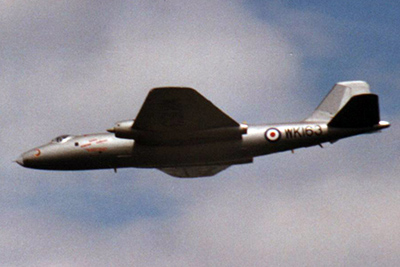
The record-breaking Scorpion Canberra; Damien Burke
The Canberra continued its run of fame in the news, with no fewer than 5 entered in the London to New Zealand Air Race of 1953 (3 RAF examples and 2 from the Royal Australian Air Force), no surprise that one of them won the race against the DC-6, Hastings and Viscount opposition!
Serviceability, as with any new aircraft, was initially spotty until common problems were ironed out, the most serious of these were runaways in the tailplane actuator - causing a number of fatal crashes until the problem was found and fixed. EE were also beginning to run up against opposition within the government and RAF to making too many improvements (and spending too much money). The Canberra was now viewed in some circles as a stopgap until the V-bombers entered service - so why bother improving them too much? In the mean time, the development of faster fighters by the opposition would soon render the Canberra's high altitude performance and speed a much less effective comfort blanket.
Squadron experience of the difficulty of bombing from high level had resulted in the adoption of more effective bombing tactics at lower altitudes, and in the central European theatre with its normally cloudy weather, your chances of seeing any target from high altitude was pretty slim anyway. Low level operations were introduced, and these made for challenging navigation, but improved the chances of getting bombs on target. The RAF Germany Canberra force were a much more tactical force, operating at low level from the very start, and with an additional interdiction role that could require fast and flexible responses to evolving situations on the ground. As such, they were slated to receive a new version of the B.6, the B(I).6, which had a belly gun pack housing 4 20mm cannons (bombs being relegated to pylons under the wing). With a lot of nose in front of the pilot, visibility for low level attacks was not ideal, however.
August 1957 found the Canberra in the news again, with a converted B.2 - WK163 - on loan to Napiers for Scorpion rocket development breaking the world altitude record, reaching 70,310ft. The same aircraft would go on to have a long and varied trials history and was not retired until 1994, and had a couple of stints of being an airshow performer in civilian hands after that.
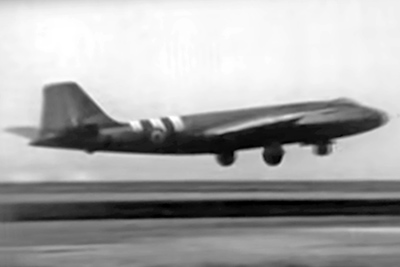
RAF Canberra in Operation Musketeer markings
1956 saw the Canberra's entry into real combat, with a deployment to Cyprus in August 1956 (and Malta soon after) in advance of operations over Suez as part of Operation Musketeer, the ill-fated Anglo-French-Israeli attempt to take control of the Suez Canal from the Egyptians. From 30th October 1956, Canberras took part in 6 days of bombing and recce sorties over Egypt and Syria. Any German civilians on the ground at the various Canberra force targets would have had unpleasant flashbacks, as the raids were in standard WW2 night attack form with target markers laying flares and bombs then delivered afterwards. Within the first 2 days the Egyptian Air Force had been more or less bombed out of existence by the Fleet Air Arm's carrier-based types, so Canberra operations proceeded without further fighter molestation from the Egyptians. However, accuracy was as bad as had been feared and only the daylight attacks saw real success. Losses, thankfully were, limited to one PR.7 (lost to a Syrian MiG-17 fighter attack with the crew ejecting) and a B.6 destroyed on take-off (crew killed) when returning to the UK for repair after receiving light damage during a raid.
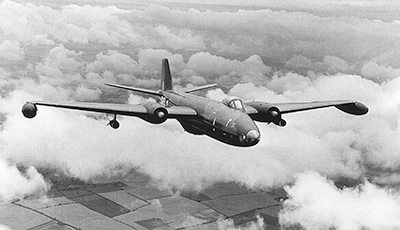
B(I).8 - interdictor Canberra; BAE Systems
Back in Europe, and a colder war, the ultimate interdictor variant was the B(I).8, with a redesigned nose solving the visibility issue by giving the pilot a raised seating position and a fighter-style canopy, albeit offset to the left, with the navigator buried in the fuselage alongside. "Buried" was about right, as the reduced space available meant there was no room for the navigator to have an ejection seat - instead they wore a chest parachute and were expected to be try and abandon the aircraft in a hurry through the normal entrance door. By March 1958 the last B(I).8 Squadron had formed (16 Squadron at Laarbruch) and these formed the backbone of the RAF's nuclear deterrent force in Germany until being replaced by Buccaneers from 1972 onwards. Back in the UK the B.6 force held the nuclear role, with their aircraft being upgraded with the Low Altitude Bombing System (LABS). This enabled low-level run-ins towards a target with a pull-up to 'toss' the bomb towards the target whilst the aircraft continued through the first half of a loop, rolling level at the top to depart the target area. It was a challenging manoeuvre in poor visibility, and more than one crew were lost practicing it.
By this time the RAF were eyeing up a replacement for the Canberra - the TSR2 - so further investment in the bomber Canberras became limited to that needed to stretch their life long enough to retain sufficient capability against the opposition in the intervening years. The B.15 and B.16 variants were introduced in 1961, basically further upgraded B.6s with improvement navigational kit and wider weapons carriage ability including rocket pods. The B.16 was further fitted with the Blue Shadow side-looking radar kit, costing the nav observer his ejection seat and relegating him to manual abandonment like the navigator in a B(I).8. By 1962 the Canberra had reached its peak usage in the RAF and its use a bomber, particular in the Main Force of Bomber Command, tailed off as the V bombers took on the load. From now on the Canberra would be a much more tactical force, with the Middle East, Near East and Far East Air Forces all continuing to operate the type.
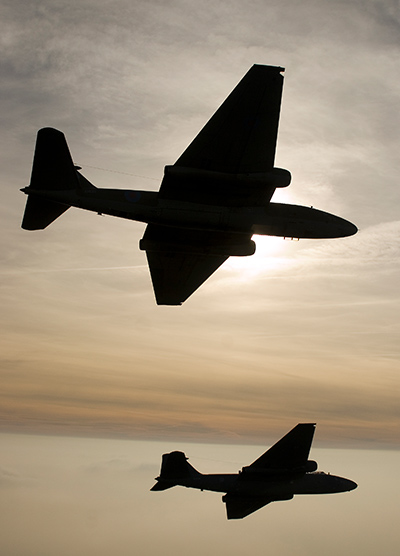
PR.9 - recce Canberras; Michael Jorgensen
One major variant not yet mentioned was the PR.9, which deserves some special attention. With the first prototype flying in mid 1955 as a PR.7 conversion, this was no small upgrade. The PR.9 was a far more capable recce bird, with many obvious and many less obvious modifications. The pilot now sat under an offset fighter style canopy (looking like that of the B(I).8, but this one actually opened), with the navigator in the forward nose (and unlike the B(I).8, sitting on an ejector seat, with access via a hinged nose cone - though early examples had no ejector seat and the first production example was lost on a test flight, killing the navigator as a result). Wing span was increased, and the inner wing sections had a larger chord; the most powerful Canberra engines so far were fitted, the RR Avon 206. Powered flying controls were now standard. If the Canberra had been the sports car of the bomber world, the PR.9 was an F1 car - and remained a challenging interception target even for supersonic fighters.
With a range of 2000 miles and endurance of up to 5 hours, and a service ceiling beyond 50,000 ft, the PR.9 was a quantum leap in recce capability. The type entered service with the RAF with 58 Squadron at Wyton in February 1960 and over the years would get regular upgrades, retaining their position as the world's leading reconnaissance aircraft for almost the entire period until their retirement - which would be a lot longer in coming. By 1965, the TSR2 was cancelled, Britain's prestige and power in the world was on the wane, and the RAF was shrinking. As a bomber, the Canberra ceded the strategic role to the V-force and, later, the tactical role to the Buccaneer and by the mid to late 1970s, the bomber Canberra was no longer in RAF service.

T.19 WH904; Chris England
The Canberra's flexibility, however, kept it going a lot longer than that. There were a slew of other variants over the years, mostly produced in relatively small numbers, often as conversions of earlier versions. The U.10 and U.14 (later D.14) were unmanned target drones to be used on the missile proving ranges at Woomera in Australia. The T.11, introduced in 1958, was a radar intercept trainer version, fitted with an air to air radar in the tip of the nose and used both for training fighter crews in the use of the radar and as a general Canberra trainer (later having the radars removed, becoming T.19s). In 1973 the Royal Navy had a similar variant, the T.22, which was a PR.7 with a Buccaneer radar in the nose. In 1965, the T.17 electronic counter measures version was produced for the single joint RAF/RN ECM unit, 360 Squadron. Laden with various 'lumps and bumps' these were busy jets with secretive duties. Finally for this variant round-up there was the TT.18, a target tug used by both RAF and RN to tow Rushton targets from underwing pods.
The T.17s would soldier on in their specialist roles until the end of the cold war in the early 1990s, but it would be the PR.9 that would carry the Canberra into another millenium. 39 Squadron (at points reduced to a unit - 1 PRU) had kept the type in a frontline role long after more modern aircraft had replaced the Canberra in offensive roles. Incredibly, the PR.9 had a 46 year career - thus playing the major part of keeping the Canberra in service non-stop from 1951 to 2006, 55 years - a record of frontline service that is unlikely to ever be broken by another British aircraft. Even at the time of retirement, the PR.9 retained a unique selection of wet film and digital cameras along with a panoramic camera, with various 'bolt on' bits of additional kit for specific duties. RAF PR.9s took part in both the 2003 Gulf campaign and in operations over Afghanistan in 2006, being fully operational until just days before retirement. A fine record for a fine aircraft.
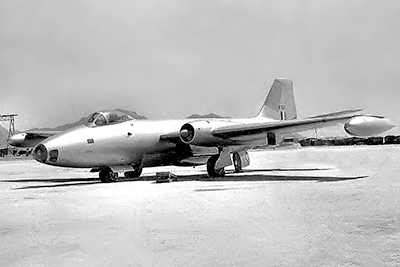
Indian Canberra B(I).58 IF907, June 1962; Ray Deacon
Of course, the Canberra story would be incomplete without mention of its overseas sales. EE and later BAC's sales efforts were a stunning success, and the aircraft sold - as rightly it should - to the Australians, who licence built it, and was also sold to Argentina, Chile, Ecuador, Ethiopia, France, India (a big customer), New Zealand, Peru, Rhodesia, South Africa, Sweden, Venezuela, West Germany and Zimbabwe. The other export customer was the United States of America, who liked it so much they also licence built the type and produced various new versions of what they termed the B-57 - but that's a whole other story, and outside the scope of this site!
The combat record of the Canberra in all of its various versions and with its various operators is a long one, covering many parts of our conflict-strewn globe, and for the most part it did its job in workmanlike albeit unspectacular fashion. However, one unfortunate aspect of the Canberra's widespread export sales was of course that the type ended up being used against British forces. In April 1982, shortly before the Argentines invaded the British territory of the Falkland Islands, they flew recce sorties over the islands to photograph potential landing areas and defences. The Argentine Canberra force would then make an aborted attack against RN ships at South Georgia (cancelled by poor weather in the target area) before entering the war for real on the 1st of May 1982. Two flights of three were sent to attack British troop ships east of the Falklands.
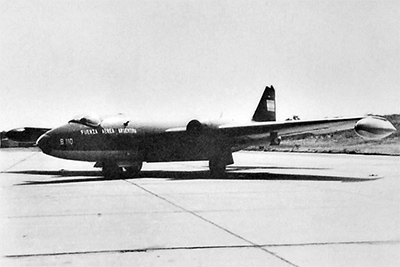
Argentine Canberra B.2 B-110; Fuerza Aerea Argentina
The sorties were not encouraging for the Argentines; the first flight found only ships of their own forces, and then suddenly stumbled across HMS Yarmouth and HMS Brilliant in low visibility - one Canberra (B-105) was damaged by collision with the waves whilst evading what they thought was a missile attack (probably just chaff rockets fired by Yarmouth) at extremely low level and the flight returned to base without dropping a bomb. The second flight fared even worse, being picked up by HMS Invincible's radar over a hundred miles away before they had begun their descent to low level to try and sneak in under the radar cover. Sea Harriers were waiting for the flight and as they approached the carrier group to within 24 miles, they were jumped. One Canberra (B-110) was shot down by a Sidewinder, and the other two jettisoned their bombs and fuel tanks to make a panicked escape amidst of flurry of other Sidewinder shots, which luckily for the Canberra crews, all missed. The crew of B-110 ejected over the sea, but were never found - partly because the Argentine patrol vessel sent to search for them was attacked by Sea Harriers and then captured.
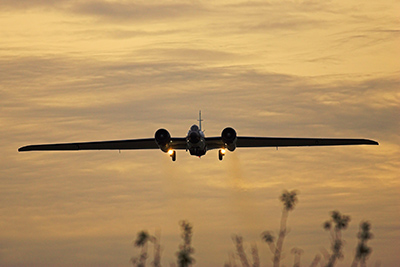
NASA WB-57F Canberra; Damien Burke
The next day two flights of two were sent against shipping, but on arrival at the target area they found nothing and returned to base. A similar raid on the 3rd of May found some ships but, once again, they were Argentine and not British and so the raid returned to base frustrated once more. A handful of maritime recce sorties were flown but by 1982, the Canberra was hopelessly obsolete as a bomber and despite the obvious bravery of their crews it finally became clear to the Argentines that daylight attacks were suicide missions and operations were shifted to night ones only. After some night training, the Canberras returned to the battle on the night of the 26th of May, but bad weather forced an early return - yet more bad luck. From the 27th of May onwards they had more success, in that they occasionally reached their targets (British troop concentrations now ashore at San Carlos), but never succeeded in doing anything other than costing the British troops some sleep. Despite some very brave low flying to bomb from heights below 1,000 ft, nothing of any consequence was ever hit and happily not a single casualty was caused. The Argentine Canberra force ended their war with another disastrous raid - which also saw a curious switch to bombing from higher altitude. Just a day before the Argentine surrender, with British troops in sight of Port Stanley, a pair of Canberras were pointlessly tasked against a British command post. With a Mirage escort to protect them from Sea Harriers, the pair bombed an entirely empty field successfully, and as they turned away, a Sea Dart fired by HMS Cardiff (which had been lying in wait to deal with any Argentine supply flights), struck the bomb bay of Canberra B-108, causing catastrophic damage. The jet fell out of the sky with the pilot ejecting into captivity and the navigator killed. A sad end to Grupo 2 de Bombardeo's war.
At the time of writing, NASA continue to operate a pair of highly modified WB-57 recce Canberras. In civilian hands, a handful of Canberras have been operated over the years, mostly in the UK and USA. By 2021 the last of the civilian operated examples (a single TT.18 now based in Australia) had been restored to flight after a period of grounding, and is incredibly back on the books of an air force, as it is now operated by the Royal Australian Air Force's Heritage Squadron. There is also an ongoing project in the USA to return another Canberra to the air, which seems much more likely to happen than the Vulcan to the Sky Trust's long-planned and so far little-worked-upon plan to return WK163 to the sky.
Leading Particulars
| Variant | Prototype | B.2 | PR.3 | T.4 | B.6/B(I).6 | PR.7 | B(I).8 | PR.9 |
|---|---|---|---|---|---|---|---|---|
| First flight | 13/05/1949 | 08/10/1950 | 31/07/1952 | 12/06/1952 | 31/03/1955 | 01/10/1954 | 08/06/1955 | 27/07/1958 |
| Crew | 2 | 3 | 2 | 3 | 2 | |||
| Armament | Nil | 6 to 10,000lb bombs | Nil | 6 to 10,000lb bombs 4 x 20mm cannon B(I).6 | Nil | As B(I).6 plus rocket pods, various nuclear bombs | Nil | |
| Powerplant | 2 x 6000lb RR Avon RA.2 | 2 x 6500lb RR Avon RA.3 | 2 x 7500lb RR Avon RA.7 | 2 x 11250lb RR Avon RA.29 | ||||
| Max. speed | ? | Placard limit 450kts (350 with tip tanks) - 500kts+ max | ? | |||||
| Service ceiling | 40,000ft | 48,000ft | 49,213ft | 60,000ft+ | ||||
| Range | ? | 2310nm | 2600nm | |||||
| Empty weight | ? | 22,000lb | ? | ? | 23,095lb | 24,994lb | ? | 28,428lb |
| Max. take off weight | ? | 42,000lb | 46,000lb | 38,000lb | 55,000lb | 56,750lb | 57,500lb | |
| Wing span | 64ft | 67ft 10in | ||||||
| Wing span + tip tanks | 65ft 6in | 67ft 10in | ||||||
| Wing area | 960 sq ft | 1,045 sq ft | ||||||
| Length | 65ft 6in | 66ft 8in | 65ft 6in | 66ft 8in | 65ft 6in | 66ft 8in | ||
| Height | 15ft 7in | |||||||
With such a wide variety of marks produced, the table above covers only the major UK variants. Total production was 1376, made up of 925 built in the UK, 403 in the USA and 48 in Australia.
